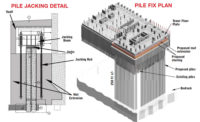San Francisco to Begin Seismic Code Update After Landmark Tall-Buildings Study

The study created a database of 156 tall buildings 240 ft or taller, primarily in the northeast section of the city.
Courtesy Tall Buildings Safety Strategy/Applied Technology Council
San Francisco is seeking input from technical experts on its landmark tall-buildings seismic safety study. Suggestions from seismic design professionals, especially about code changes, will help inform the city’s path forward, in terms of implementing the 16 recommendations in the $400,000 report, called the Tall Buildings Safety Strategy.
“Everyone is committed to seismic safety,” says Bill Barnes, a spokesman for the city’s Office of Resilience and Capital Planning, which commissioned the study. “The big issue is timeline and cost.”
The city released the final 374-page report, prepared by the Applied Technology Council (ATC), on Jan. 10. The recommendations came out last Oct. 4. The 14-month study--which created a database of the 156 buildings 240 ft or taller, primarily in the northeast section--is part of the city’s 30-year Earthquake Safety Implementation Program.
“We know an earthquake is coming,” says the report. “The U.S. Geological Survey estimates there is a 72% chance of a magnitude 6.7 or greater earthquake before 2043.”
Many of the recommendations require legislative, budgetary and code changes. The city will decide this year which recommendations will be implemented through changes in the city’s building code, which is undergoing an update in alignment with the triennial update of the statewide building code. The city’s code update will be adopted later in 2019 and go into effect in 2020.
Code Update
In March, the city’s Dept. of Building Inspection begins work on the code update, after state regulators vote on the state code this month.
“The timing is ideal because rather than separate legislation we can use the existing code update process to implement the recommendations,” says Barnes, who adds that the concurrence of the report and the code update is serendipitous.
To date, there are no cost estimates and no timeline for implementing the report’s recommendations. For existing buildings, the city will begin to estimate a range of costs.
The first next step is to “socialize the recommendations with policymakers,” says Barnes. Concurrently, the city expects to get feedback from all stakeholders, including owners and developers of tall buildings, he adds.
The study contains wide-ranging recommendations and a timeline for their implementation, either short-, mid- or long-term, says Ayse Hortacsu, ATC’s director of projects.
Existing Buildings
For example, the report advises the city to update and amend its code for existing buildings, to develop new policies and procedures to implement the state’s safety assessment program, and to maintain and expand its database of tall buildings.
For new buildings, the report considers stricter recovery-based seismic design standards, which would go beyond the life-safety provisions in the code. One recommendation is to develop a comprehensive recovery plan for the financial district and adjacent neighborhoods.
“If you read between the lines, you see the idea of ‘functional recovery,’ which goes beyond life safety and takes into account commerce, tourism” and more, says David Bonowitz, a structural engineer on the 13-member ATC study team.
To reduce seismic risk to new tall buildings, San Francisco should develop regulations to address foundation and geotechnical issues, says the report. The city also should set performance-based design standards.
For existing high-rises, the city should enforce repair provisions of the building code, with respect to damage from 1989’s magnitude-6.9 Loma Prieta earthquake, and amend the code to include triggers for seismic upgrades.
Steel Moment Frames
In particular, the report recommends actions, such as inspections and necessary fixes, regarding welded steel moment frames built prior to Loma Prieta. Seismic code provisions for welded connections in moment frames changed after 1994’s magnitude-6.7 Northridge quake, near Los Angeles, uncovered brittle fractures of welds.
Ground motion records from Loma Prieta can narrow the field of steel moment frames that might have been damaged in Loma Prieta, says John D. Hooper, director of earthquake engineering for Magnusson Klemencic Associates and the task leader of the report’s four-person technical committee.
During Loma Prieta, shaking was not all that strong. “My guess is less than a handful of buildings were affected,” says Hooper. In those buildings, only 10% to 15% of the welds would need to be inspected, he says, both visually and through ultrasonic testing.
As for next steps, ATC has been helping the Office of Resilience and Capital Planning inform decision-makers. In addition to informational presentations to the Building Inspection Commission, the Planning Commission and others in city government, ATC is planning an outreach event with the Structural Engineering Association of Northern California, for early next month. The report team also is assisting in the maintenance and update of the database on an as-needed basis.
The study can be a model for other jurisdictions in seismic zones. Toward this end, Barnes says the city is beginning to talk with other communities, both through the U.S. Conference of Mayors, the Earthquake Engineering Research Institute, other buildings’ departments and emergency managers.
“This is a big step forward for San Francisco. Seattle and Los Angeles could benefit from this,” says Hooper.







